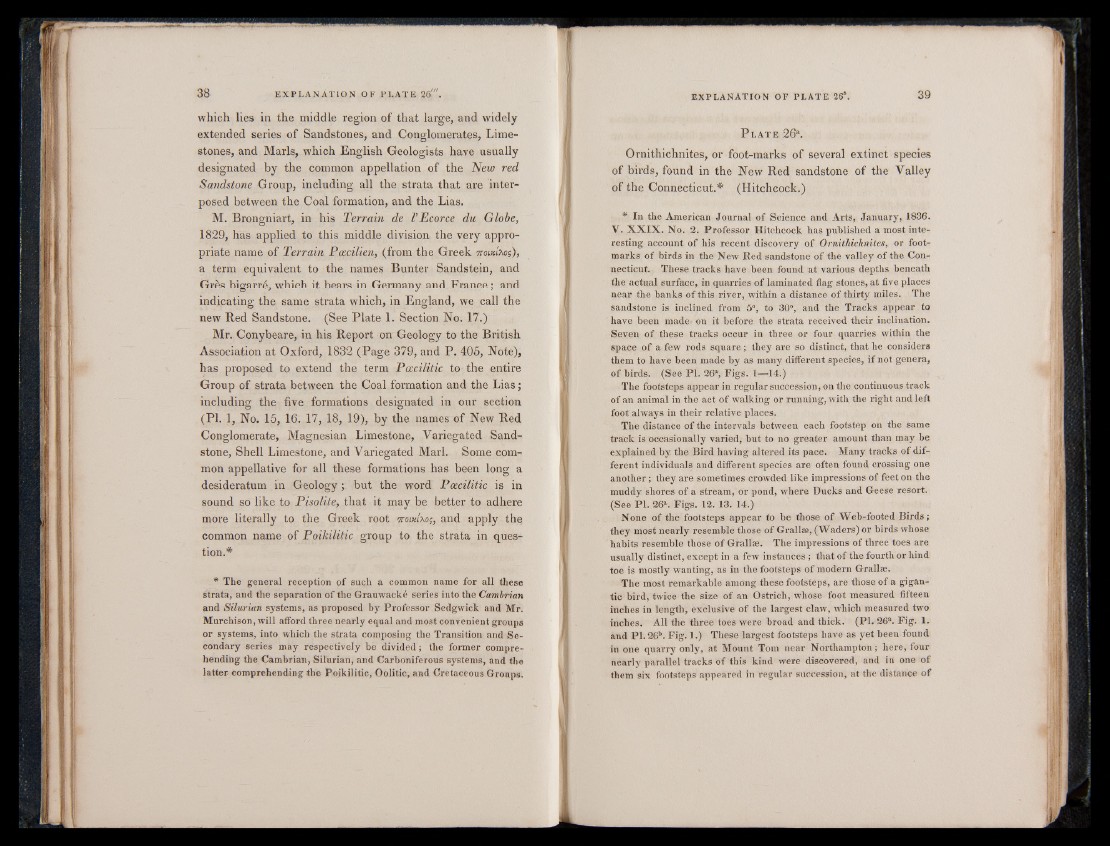
which lies in the middle region of that large, and widely
extended series of Sandstones, and Conglomerates, Limestones,
and Marls, which English Geologists have usually
designated by the common appellation of the New red
Sandstone Group, including all the strata that are interposed
between the Coal formation, and the Lias.
M. Brongniart, in his Terrain de 1’Ecorce du Globe,
1829, has applied to this middle division the very appropriate
name of Terrain Ptzcilien, (from the Greek nom^o;),
a term equivalent to the names Bunter Sandstein, and
Grès bigarré, which it bears in Germany and France; and
indicating the same strata which, in England, we call the
new Red Sandstone. (See Plate L Section No. 17.)
Mr. Conybeare, in his Report on Geology to the British
Association at Oxford, 1832 (Page 379, and P. 405, Note),
has proposed to extend the term Poccilitic to the entire
Group of strata between the Coal formation and the Lias;
including the five formations designated in our section
(PI. 1, No. 15, 16. 17, 18, 19), by the names of New Red
Conglomerate, Magnesian Limestone, Variegated Sandstone,
Shell Limestone, and Variegated Marl. Some common
appellative for all these formations has been long a
desideratum in Geology; but the word Pcecilitic is in
sound so like to Pisolite, that it may be better to adhere
more literally to the Greek root womlhos, and apply the
common name of Poikilitic group to the strata in question.*
* The general reception of such a common name for all these
strata, and the separation of the Grauwacké series into the Cambrian
and Silurian systems, as proposed by Professor Sedgwick and Mr.
Murchison, will afford three nearly equal and most convenient groups
or systems, into which the strata composing the Transition and Secondary
series may respectively he divided; the former comprehending
the Cambrian, Silurian, and Carboniferous systems, and the
latter comprehending the Poikilitic, Oolitic, and Cretaceous Groups.
P late 26%
Ornithichnites, or foot-marks of several extinct species
of birds, found in the New Red sandstone of the Valley
of the Connecticut.* (Hitchcock.)
* In the American Journal of Science and Arts, January, 1836.
V. XXIX. No. 2. Professor Hitchcock has published a most interesting
account of his recent discovery of Ornithichnites, or footmarks
of birds in the New Red sandstone of the valley of the Connecticut.
These tracks have been found at various depths beneath
the actual surface, in quarries of laminated flag stones, at five places
near the banks of this river, within a distance of thirty miles. The
sandstone is inclined from 5°, to 30°, and the Tracks appear to
have been made, on it before the strata received their inclination.
Seven of these tracks occur in three or four quarries within the
space of a few rods square; they are so distinct, that he considers
them to have been made by as many different species, if not genera,
of birds. (See PI. 26% Figs. I—14.)
The footsteps appear in regular succession, on the continuous track
of an animal in the act of walking or running, with the right and left
foot always in their relative places.
The distance of the intervals between each footstep on the same
track is occasionally varied, but to no greater amount than may be
explained by the Bird having altered its pace. Many tracks of different
individuals and different species are often found crossing one
another; they are sometimes crowded like impressions of feet on the
muddy shores of a stream, or pond, where Ducks and Geese resort.
(See PI. 26% Figs. 12. 13. 14.)
None of the footsteps appear to be those of Web-footed Birds;
they most nearly resemble those of Grail as, (Waders) or birds whose
habits resemble those of Grallas. The impressions of three toes are
usually distinct, except in a few instances ; that of the fourth or hind
toe is mostly wanting, as in the footsteps of modern Grallas.
The most remarkable among these footsteps, are those of a gigantic
bird, twice the size of an Ostrich, whose foot measured fifteen
inches in length, exclusive of the largest claw, which measured two
inches. All the three toes were broad and thick. (PI. 26% Fig. 1.
and P1.26b. Fig. 1.) These largest footsteps have as yet been found
in one quarry only, at Mount Tom near Northampton; here, four
nearly parallel tracks of this kind were discovered, and in one of
them six footsteps appeared in regular succession, at the distance of